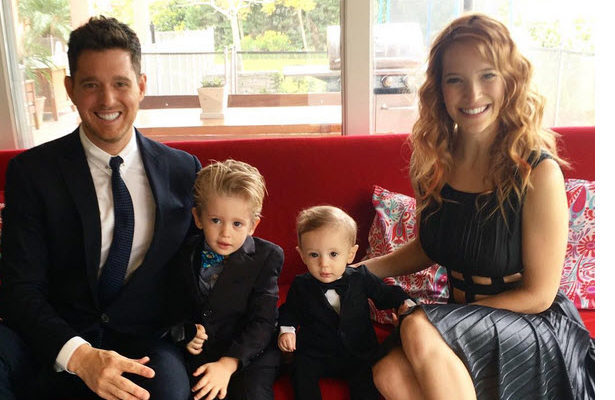Michael Buble’s Son Noah Treated for Liver Cancer

Many were stunned when, earlier this month, singer Michael Bublé announced that he has cancelled all his upcoming appearances. He and his wife, Lusiana Lopilato, must help care for his son, Noah, who had been diagnosed with cancer:
“We are devastated about the recent cancer diagnosis of our oldest son Noah who is currently undergoing treatment in the US. ”
We now know that that Noah Bublé was diagnosed with liver cancer following a biopsy of his liver. He is undergoing chemotherapy, which will last 4 months.
Bublé’s sister-in-law, Daniela Lopilato, told an Argentinian magazine, Gente:
“Cancer is a horrible illness but we have faith in Noah being able to overcome this. We know he will. The time to start a long and very difficult treatment has come but it’s got to be done. They say children are normally strong to put up with chemotherapy and my nephew is a warrior.”
What should I know about liver cancer in children?
Liver cancer is rare in children and adolescents. There are two main types of childhood liver cancer:
Hepatoblastoma: Hepatoblastoma is the most common type of childhood liver cancer. It usually affects children younger than 3 years of age. In hepatoblastoma, the histology (how the cancer cells look under a microscope) affects the way the cancer is treated. The histology for hepatoblastoma may be one of the following:
- Pure fetal histology
- Small cell undifferentiated histology
- Non-pure fetal histology, non-small cell undifferentiated histology.
Hepatocellular carcinoma: Hepatocellular carcinoma usually affects older children and adolescents. It is more common in areas of Asia that have high rates of hepatitis infection than in the U.S.
Because it is much more likely that Noah has been diagnosed with hepatoblastoma, we will concentrate on this type of cancer.
First, a little about the liver…
The liver is one of the largest organs in the body. It has four lobes and fills the upper right side of the abdomen inside the rib cage. Three of the many important functions of the liver are
- Act as a filter for harmful substances from the blood so they can be passed from the body in stools and urine.
- Making bile to help digest fats from food.
- To store glycogen (sugar), which the body uses for energy.
How common is hepatoblastoma?
- Approximately 50-70 new cases/year in the US
- 1% of all pediatric cancers.
- 95% diagnosed under 4 years of age.
- In 50% of the cases the disease can be cured by surgery alone.
- The 5 year survival rate for the combined stages of hepatoblastoma is 60%-70%. The prognosis for early stage disease is excellent with a 90% five year survival.
What are the risk factors?
Risk factors for hepatoblastoma include the following syndromes or conditions:
- Aicardi syndrome.
- Beckwith-Wiedemann syndrome.
- Familial adenomatous polyposis (FAP).
- Glycogen storage disease.
- A very low weight at birth.
- Simpson-Golabi-Behmel syndrome.
- Certain genetic changes, such as Trisomy 18.
 From the National Cancer Institute
From the National Cancer Institute
What are the symptoms?
Signs and symptoms are more common after the tumor gets big. Other conditions can cause the same signs and symptoms. Therefore, check with your child’s doctor if your child has any of the following:
- A lump in the abdomen that may be painful
- Swelling in the abdomen
- Weight loss for no known reason
- Loss of appetite
- Nausea and vomiting
How is hepatoblastoma treated?
Treatment options for hepatoblastoma that can be removed by surgery includes the following:
- Surgery to remove the tumor, followed by watchful waiting or chemotherapy, for hepatoblastoma with pure fetal histology.
- Surgery to remove the tumor, with combination chemotherapy given either before surgery, after surgery, or both, for hepatoblastoma that is not pure fetal histology. For hepatoblastoma with small cell undifferentiated histology, aggressive chemotherapy is given.
Treatment options for hepatoblastoma that cannot be removed by surgery or is not removed at the time of diagnosis may include the following:
- Combination chemotherapy to shrink the tumor, followed by surgery to remove the tumor.
- Combination chemotherapy followed by a liver transplant.
- Chemoembolization of the hepatic artery to shrink the tumor, followed by surgery to remove the tumor.
For hepatoblastoma that has spread to other parts of the body at the time of diagnosis, combination chemotherapy is given to shrink the cancer in the liver and cancer that has spread to other parts of the body. After chemotherapy, imaging tests are done to check whether the cancer can be removed by surgery:
- If the cancer in the liver and other parts of the body can be removed, surgery will be done to remove the tumors followed by chemotherapy to kill any cancer cells that may remain.
- The treatment may be a liver transplant if:
- the cancer in the liver cannot be removed by surgery AND
- there are no signs of cancer in other parts of the body
- If the cancer in other parts of the body cannot be removed or a liver transplant is not possible, chemotherapy, chemoembolization of the hepatic artery, or radiation therapy may be given.
Source: National Cancer Institute



























0 comments